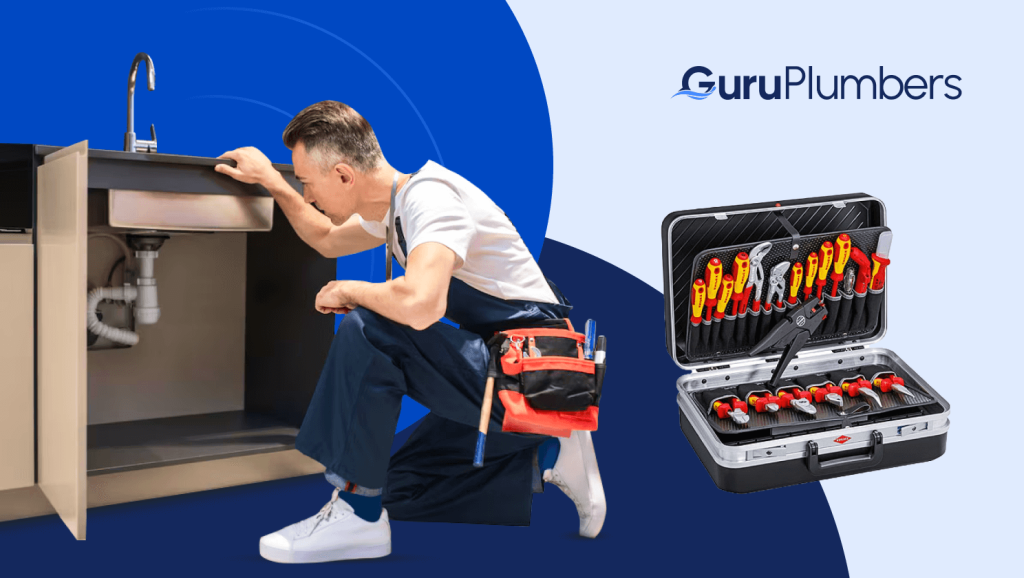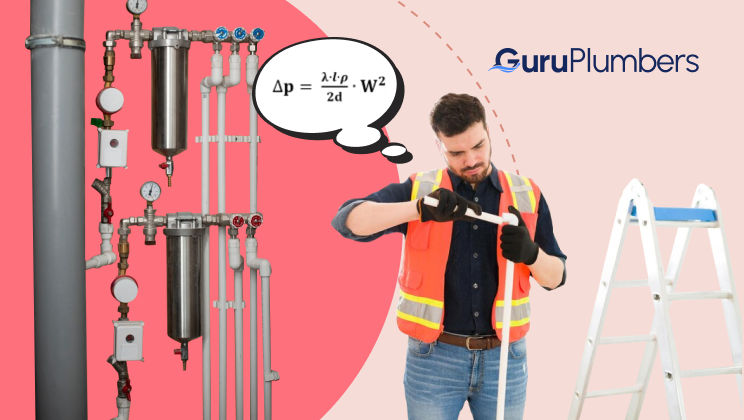Understanding sink plumbing is essential for maintaining a functional and efficient kitchen or bathroom. By knowing the basics for both kitchen and bathroom sinks, you can quickly address common issues, save on repair costs, and prevent more significant problems from developing.
We look at sink plumbing’s basic components and how they compliment each other in this blog post. You’ll also learn about common plumbing problems and how to address them.
Basic Components of Sink Plumbing
Sink Basin
The sink basin, including the sink bowl, is the bowl-shaped part of the sink that holds water. It’s available in various materials such as stainless steel, porcelain, and composite. The basin typically has one or more holes for the faucet and drain assembly.
Faucet
The faucet controls the flow of water into the sink. It consists of handles (or a single handle), spout, and internal valves that regulate water temperature and pressure. Faucets come in different styles, including single-handle, double-handle, and touchless models.
Drain and P-trap
Water flows out of the drain at the bottom of the sink basin. Rough corrugated tubing in drain trap kits can catch grease and food particles, causing clogs in kitchen drains. Using the P-trap, you can prevent sewer gases from entering your home by capturing debris. The P-trap also holds a small amount of water to maintain a seal against gas leaks.
Water Supply Lines
Water supply lines deliver hot and cold water to the faucet. These lines are usually flexible hoses made of braided stainless steel or reinforced plastic. They connect to the shut-off valves and the faucet’s inlets.
Shut-off Valves
Shut-off valves are located under the sink and control the flow of water to the faucet. They allow you to turn off the water supply for maintenance or in case of a leak. There are usually two shut-off valves: one for hot water and one for cold water.
Common Sink Plumbing Issues
Leaky Faucet
A leaky faucet is often caused by worn-out washers, O-rings, or seals. As a result, water is wasted and utility bills are raised. Identifying the type of faucet (compression, ball, cartridge, or ceramic disk) helps in finding the right repair solution.
Clogged Drain
Most drain clogs occur due to hair, soap scum, food particles, or grease. When using a garbage disposal, run cold water while using it and avoid disposing of fibrous or starchy foods. They can cause water to back up in the sink, creating an unpleasant mess and potential odors.
Slow Draining Sink
A slow draining sink is usually a sign of a partial clog in the drainpipe or P-trap. Improper alignment of the waste pipe can also contribute to slow drainage by preventing water from flowing smoothly. Standing water can also result from mineral deposits in the pipes, reducing water flow.
Low Water Pressure
Low water pressure can result from clogged aerators, buildup in the supply lines, or issues with the municipal water supply. It affects the performance of your faucet, making it difficult to get an adequate water flow.
Leaky Pipes
Leaky pipes can occur due to corrosion, loose connections, or physical damage. They can cause water damage to cabinets, floors, and walls, and contribute to mold growth if not addressed promptly. The most important thing you can do to protect your home from water damage is to address leaks as soon as possible.
Tools You Need for Sink Plumbing
Adjustable Wrench
An adjustable wrench is versatile and can fit various sizes of nuts and bolts. It’s essential for tightening or loosening plumbing connections. An adjustable wrench is also crucial for tasks like sink installation, including connecting water supply lines, waste/vent pipes, and P-traps.
Plunger
A plunger is used to clear clogs in drains by creating a vacuum that dislodges the blockage. It’s a first-line tool for dealing with sink clogs.
Pipe Wrench
This is a tool for gripping, turning, and removing pipes and fittings with smooth surfaces. It’s essential for working on larger pipes and stubborn fittings.
Plumber’s Tape
Teflon tape, or plumber’s tape, is used to seal threaded connections. It prevents leaks by ensuring a tight, watertight fit.
Basin Wrench
A basin wrench has a long handle and a pivoting jaw, making it ideal for reaching and tightening nuts in hard-to-access areas, such as under sinks.
Plumber’s Snake
A plumber’s snake, or drain auger, is used to clear stubborn clogs in drain pipes. It can reach further down the pipe than a plunger and is effective for removing deeper blockages.
Step-by-Step Guide to Fixing Common Problems
Fixing a Leaky Faucet
Identify the Type of Faucet
- Compression: Separate hot and cold handles.
- Ball: Single handle, ball mechanism.
- Cartridge: Single or double handle, smooth handle movement.
- Ceramic Disk: Single handle, wide, cylindrical body.
Step-by-Step Repair Process
- Turn off the water supply.
- Plug the drain to prevent losing small parts.
- Disassemble the faucet:
- For compression faucets: Replace washers.
- For ball faucets: Replace cam assembly, ball, and springs.
- For cartridge faucets: Replace cartridge.
- For ceramic disk faucets: Replace ceramic disks.
- Reassemble the faucet.
- Turn on the water supply and test for leaks.
- If installing a new sink, check the depth and ensure proper alignment with the drain outlet. Consider adjustments for components like garbage disposal.
Unclogging a Drain
Using a Plunger
- Make sure the plunger cup is covered with water in the sink.
- Place the plunger over the drain.
- Pump the plunger up and down vigorously.
- The water should drain if the plunger is removed.
Using a Plumber’s Snake
- Insert the snake into the drain.
- Advance the snake by turning the handle clockwise.
- When you feel resistance, continue turning to break up the clog.
- Clean off any debris left behind after retracting the snake.
- Flush the drain with hot water.
The process may vary if dealing with two sinks connected to one outlet.
Resolving Low Water Pressure
Check for Blockages
- Make sure the water supply lines are not kinked or blocked.
- Ensure the shut-off valves are fully open.
Clean Aerator
- Unscrew the aerator from the faucet.
- Disassemble the aerator and soak in vinegar to remove mineral deposits.
- Rinse and reassemble the aerator.
- Reinstall the aerator on the faucet and test the water flow.
Repairing Leaky Pipes
Locating the Leak
- Inspect visible pipes for moisture or water droplets.
- Use a flashlight to check hard-to-see areas.
Temporary Fixes and Permanent Solutions
- Temporary Fixes:
- Apply plumber’s tape around the leak.
- Use a pipe repair clamp.
- Permanent Solutions:
- Turn off the water supply.
- Cut out the damaged section of the pipe using a pipe cutter.
- Replace with a new section of pipe and secure with appropriate fittings.
- Turn on the water supply and check for leaks.
Maintenance Tips for Sink Plumbing
Regular Inspection of Pipes and Connections
- Check for signs of corrosion, leaks, and loose connections.
- Tighten any loose fittings and replace damaged pipes.
Cleaning the Drain and P-Trap
- Remove and clean the P-trap regularly to prevent buildup.
- Use a natural drain cleaner (e.g., baking soda and vinegar) monthly.
Keeping the Faucet Aerator Clean
- Aerators should be removed and cleaned periodically to prevent mineral build-up.
- Soak the aerator in vinegar, rinse, and reattach.
Using Drain Guards to Prevent Clogs
- Install drain guards to catch hair, food particles, and debris.
- Clean the drain guards regularly to maintain water flow.
Maintaining the Kitchen Sink
- Prevent odors and buildup by regularly cleaning the garbage disposal.
- Check for leaks around the sink and the drain assembly.
- Ensure proper drainage by checking the height of the trap arm and the configuration of the sink plumbing.
When to Call a Professional Plumber
Identifying Issues Beyond DIY Repair
- Persistent clogs that don’t respond to plunging or snaking.
- Continuous low water pressure despite cleaning the aerator and checking supply lines.
- Major leaks that require pipe replacement or extensive repair.
- Sewer odors indicating a potential problem with the drain system.
- Water damage on walls or floors suggesting hidden leaks.
Importance of Professional Inspection and Repair
- Diagnose and fix complex issues can be accomplished by a professional plumber.
- Proper repairs prevent further damage and expensive repairs down the line.
- Ensures that plumbing systems comply with local codes and standards.
- Provides peace of mind with guaranteed work quality and safety.
Final Thoughts
Regular maintenance of your sink plumbing ensures efficient operation and prevents costly repairs. Preventing major disruptions and keeping your plumbing in good condition can be achieved by staying proactive.




